I am sure by now you have heard about the Milwaukee cordless miter saw. Lose the cord and enjoy some freedom on your next job site and all thanks to Milwaukee. We first saw this miter saw at the Milwaukee event and have to say we were initially impressed, but as you know it’s always different once you get a tool in your hands and your environment. So with that said, let’s take a look at the Milwaukee Cordless Miter Saw Review.
Okay, let’s be honest. We know these type of tools take a ton of power to run, so how good or useful can a cordless saw really be? As soon as you start cutting with a miter saw, you can see the lights dim or the generator kick up and that is because it does take a ton of power. So when Milwaukee said they had a cordless miter saw on the market, I was expecting something a little different. I was expecting to see a 6 1/2″ saw or maybe a 7 1/4″, but not a 10″ saw.
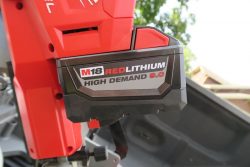 So the first question is how are they going to produce enough power to make this miter saw a useful tool? Milwaukee is powering these saws with their 9Ah battery. Yes, you read that right, it’s a 9Ah battery and it’s part of their M18 battery platform. So really this is a win win scenario. Not only do you have a battery powerful enough to run a 10″ miter saw, but it will work with most of your M18 tools. Great news for people who have other tools that draw a lot of amps like a rotary hammer, circular saw and more.
So the first question is how are they going to produce enough power to make this miter saw a useful tool? Milwaukee is powering these saws with their 9Ah battery. Yes, you read that right, it’s a 9Ah battery and it’s part of their M18 battery platform. So really this is a win win scenario. Not only do you have a battery powerful enough to run a 10″ miter saw, but it will work with most of your M18 tools. Great news for people who have other tools that draw a lot of amps like a rotary hammer, circular saw and more.
Okay, so this saw has power, but what about run time? With the High Demand 9Ah battery you make up to 400 cuts in 3-1/2″ baseboard trim, 300 cuts through 2 x 4 or 150 cuts in 2×12 lumber. Now we didn’t actually test the number, this is just something we will take their word for. I can tell you that the days we did use this saw, we made a ton of cuts and the battery kept up.
In regards to features of this tool, it has all your standard options that other miter saws have. However Milwaukee being Milwaukee, they did some things different which we will get into in a bit. This saw has an adjustable stainless steel detent plate, 11 miter detent locations, 9 bevel detent locations, detent override, cam locking system, bevel adjustments, trenching capability and miter lock. So don’t worry that this is a cordless saw, Milwaukee didn’t cut any corners.
One item you will notice on the saw is the word “Fuel”. For those who know about the Fuel, this is a welcome addition. For those who don’t, Fuel means the saw is powered by a brushless motor. A brushless motor has some benefits like longer life, more efficient and longer run time. As far as capacity, the numbers aren’t too shabby. The vertical capacity is 5-3/4″ with a 2 x 12 horizontal capacity. For miter setting it’s a 50°/60° and for bevel it’s 48° for both left and right.
Now that you know a little bit about the saw regarding the design, features and capacity, let’s jump into the saw itself.
One item you might notice is the rail system. While most miter saws have a rail system on top of the saw, Milwaukee decided to use a lower rail system. I have to admit, I am not sure why they went this way or what the advantages are, but it is an interesting design. Personally I think it has some pros and cons. It seems with the rail system on the bottom, the rails are protected when transporting. Most of the time, sliding miter saws are tossed around when you move them from job to job. It’s very easy to toss stuff around and hit rails when they are exposed on the top of the saw. At least with the rails on the bottom, you can lock them in place and they are somewhat protected during transport. One reader brought up with the rails on the bottom, they could get dirtier as far as debris hitting the rails since they are on the bottom. Also, more dirt build up with the rails on the bottom. Why this might be true, it seems like saw dust and other debris won’t be an issue. In regards to the rail system, I can’t say the bottom rail performs any better or worse than the top rail system. There might be a weight difference and not top heavy with a bottom rail system, but again, not something I could really feel.
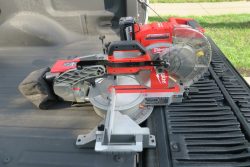 Speaking of transporting, I have to say that Milwaukee did a fine job with keeping that aspect of a portable miter saw in mind. The saw only weighs 45 lbs, so it’s not extremely heavy when moving it around. Another feature they implemented was a top handle and two side handles. Both great and easy ways to move it from one spot to another. Moving the saw from one location to another is where I saw the biggest benefit for the bottom rail system. If you have moved a top rail system around, you know it can be a little cumbersome. With the bottom rail system, it just felt more like I was moving a miter saw around and not a sliding miter saw. It was a little easier and wasn’t placed in an awkward position.
Speaking of transporting, I have to say that Milwaukee did a fine job with keeping that aspect of a portable miter saw in mind. The saw only weighs 45 lbs, so it’s not extremely heavy when moving it around. Another feature they implemented was a top handle and two side handles. Both great and easy ways to move it from one spot to another. Moving the saw from one location to another is where I saw the biggest benefit for the bottom rail system. If you have moved a top rail system around, you know it can be a little cumbersome. With the bottom rail system, it just felt more like I was moving a miter saw around and not a sliding miter saw. It was a little easier and wasn’t placed in an awkward position.
Another con to the bottom rail system is dust management. Not that this saw is bad for dust management and not that I have seen a mind blowing dust management system. Granted they are all good when you hook it up to a vac. I am talking about just using the bagging system. With a top rail system, it seems that when you make a cut, the blade is always close to where the dust is expelled into the bag. With the bottom rail system, if you have the slide all the way forward, the bagging system is farther away and just didn’t seem like it collected that great. When just using in the chop saw mode, it did a decent job at collecting the saw dust.
Again, Milwaukee did an excellent job with the design and implementation of this saw, but two areas that I thought hit home, besides performance was the light and chop saw mode. Yes, there is a ton to love about this saw, but I love the lighting system with this saw. This saw uses a shadow feature to show where the blade will be cutting. This is a very nice system as it seems to be more true over time than a laser. While it doesn’t work that great in direct sun light (none really do), it does great in your average work environment. The next item was chop saw mode. If you want to use your sliding saw in a chop saw mode, you usually have to tighten a thumb screw down. Not that it’s a big deal, but it can take time when you are moving from one mode to another mode frequently. With the Milwaukee miter saw there is a lever on the front of the saw that allows the user to quickly transition from sliding to chop if you want to do a quick cut in a different mode. Now there is still a thumb screw to lock the sliding for transport, but this quick lever is great.
Everything about this saw screams quality. When you move the bevel, miter or the slider, they just all feel like quality was built into this saw. Nothing feels cheap. The levers all have a little bit of resistance to them. Changing your miter angle is free flowing and smooth. Pressing the on switch on the D-handle feels great, not like some of the cheap buttons we have seen on other manufacturers saws. Even moving the saw up and down for your cuts, well let’s just say it feels like a champ.
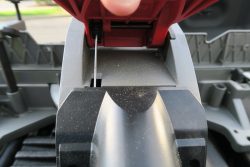 As far as the bevel settings, Milwaukee has a unique approach. Most saws you will have to loosen a screw in order to move it left or right. Sometimes it can be awkward trying to reach around and loosen or tighten the screw. With the Milwaukee, they have a little different way of doing it. Just lift a lever located on the back of the saw and you can make a quick and easy change to your bevel setting. While it did take a couple of tries to get used to, I really love this set up. It’s quick and easy. The only thing that concerns me is the system uses a metal cord. So as you lift on the lever, it pulls a metal cord to release the saw and make your bevel setting. My only concern is I haven’t seen something like this, so how will it hold up over time? Can it get damaged? What is holding that cord to each location? Will it stress over time? Now it’s Milwaukee, so I am sure they thought of the long term use, but for me, only time will tell.
As far as the bevel settings, Milwaukee has a unique approach. Most saws you will have to loosen a screw in order to move it left or right. Sometimes it can be awkward trying to reach around and loosen or tighten the screw. With the Milwaukee, they have a little different way of doing it. Just lift a lever located on the back of the saw and you can make a quick and easy change to your bevel setting. While it did take a couple of tries to get used to, I really love this set up. It’s quick and easy. The only thing that concerns me is the system uses a metal cord. So as you lift on the lever, it pulls a metal cord to release the saw and make your bevel setting. My only concern is I haven’t seen something like this, so how will it hold up over time? Can it get damaged? What is holding that cord to each location? Will it stress over time? Now it’s Milwaukee, so I am sure they thought of the long term use, but for me, only time will tell.
When we first received this saw, we did a Periscope on it and a ton of people wanted to know the same thing. When you make a cut with a large miter angle and bevel angle, will the saw hit the fence? To answer this question, yes it will hit the fence. However it doesn’t hit the stationary fence. It will hit the movable fence and yes you can rip into that. I haven’t seen any saw where it won’t hit the movable fence. This is just something you have to deal with on all miter saws, it’s a fact of life. Now there are certain extreme angles where the movable fence will stop your cut as it will hit part of the housing of the saw. Not that it will damage anything, but it will cause you to stop during a cut. But again, you should always check this before actually making a cut and make sure everything will be clear before you start your cut.
We did notice that when cutting a 4 x 6, it would cut through the wood without bogging down, we did have to lift the saw about an 1/8″ to finish the cut. It would have been nice if the housing or something could have been slightly adjusted so you wouldn’t have this issue.
The other item was changing the blade. With the Milwaukee miter saw, it’s very easy to change the blade. Best of all the arbor lock is easy to hold on to when loosening the blade screw. So I really don’t have any issues with that and it’s easy if you have to change your blade from a rip to plywood or whatever reason you are going to change the blade.
Milwaukee Cordless Miter Saw Review Specification
- RPM 4,000
- Max Miter Capacity 50 / 60
- Vertical Capacity Against Fence 5-3/4″
- Vertical Capacity Nested Crown 5-1/4″
- 90 Cross Cut Capacity 2 x 12
- 45 Miter Cross Cut Capacity 2 x 8
- 45 Bevel Cut Capacity 2 x 12
- Weight 45 lbs
- Maximum Bevel Capacity 48 / 48
- Tool Warranty 5 Years
Milwaukee Cordless Miter Saw Review Final Thoughts
Bottom line I think Milwaukee made a heck of a sliding miter saw. The saw is a quality saw that not only has a ton of features, but it’s powerful. Moving the saw from location to location is easy with the handle options. Setting your miter or bevel angles are convenient and easy to set up. Overall I love this saw. I know I had a couple of issues, but they are minor. When you look at the saw as a whole, Milwaukee did a great job with the design of this saw. One thing I would really love to see is what Dewalt did with their miter saw and that is being able to run off a battery or plug it into an outlet. I love having both options available.
Check out the Milwaukee Miter Saw at The Home Depot

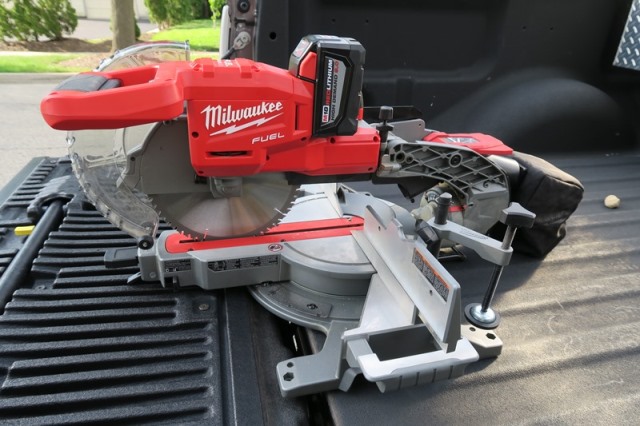


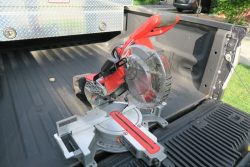
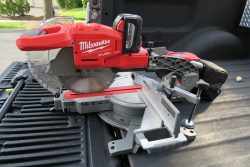
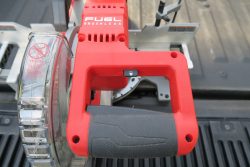
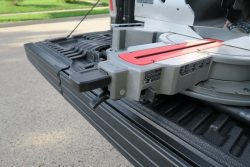
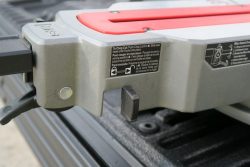
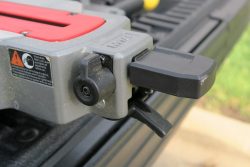
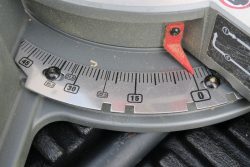

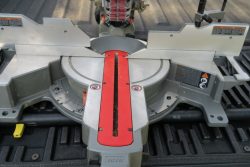
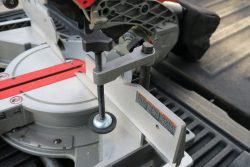
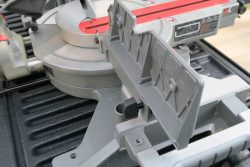
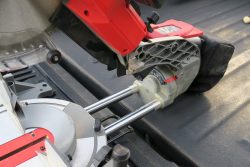
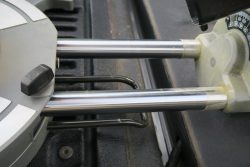
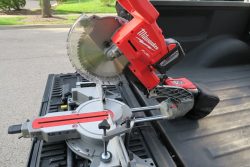
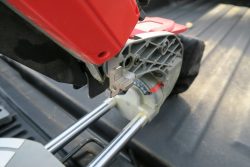
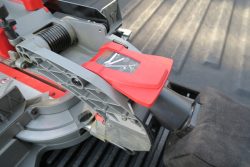
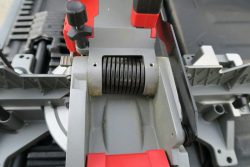
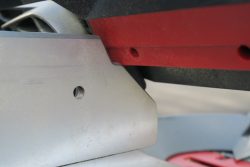
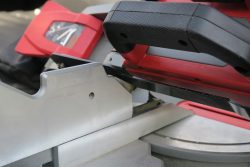
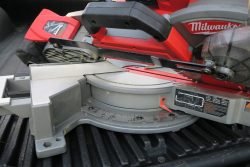
Not being able to also plug it in is a deal breaker.
I don’t know about that Joey. In my case, I already have Milwaukee tools. I would get it with the 9.0 amp battery, and that would help with my other milwaukee saws. It might be a deal breaker for some people, but in many cases i would take this over a corder or the Dewalt flexvolt. I guess it just depends on what you do.
Ive heard left or right on the saw for yay or nay, issues I’ve heard was compound miter fence has to come off and the springs were too stiff causing deflection and rails not being the most solid, but on the other hand I’ve seen highly accurate work done with it, i love the portability of this saw over the fllexvolt and think for a cordless option is the better route over the flex but don’t think its a better saw, regardless its an awesome saw! #tiacrew
Been a while since I’ve been on here. I see a tool fight coming tho!
welcome back
Get write up Eric. Looks like a solid saw, still interested in the DW but this is a really nice saw they came out with.
Looks great. On fence for this or a corded hitachi or Bosch in 12″. Love the idea of no cords and this would have helped me a ton. But like some features of the other and the all day plug in power would be nice. I would do flexvolt for both, but already run m18 and if running plugged in, i like the others better.
Love the idea of no cords.
You talk at length about all the features but haven’t reviewed the accuracy or quality of the cuts. What good is that to a woodworker?.
Sorry, I thought I talked about that in the article. For the two we tested, ours and one we gave to a GC, both were accurate. We didn’t use it for fine woodworking. We used it for framing and some trim work, all of which it was accurate and we were happy with the cuts. In regards to quality of the cuts, it depends on which blade you have. We used the stock blade for our framing work. When we did trim work, we used a Diablo blade that had more teeth, so we had a better cut. If you are doing finish work, I would switch blades. If you are doing more framing, the included blade works great.